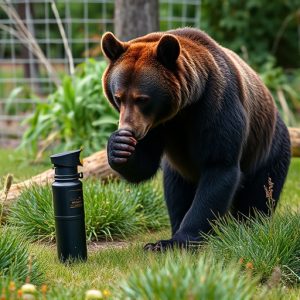Mastering Bear Spray Defense: Storage & Effective Use Against Predators
Bear spray, an essential tool for safety in bear-inhabited areas, uses capsaicin to deter attacks. I…….
Bear spray, an essential tool for safety in bear-inhabited areas, uses capsaicin to deter attacks. It must be stored within a temperature range of 10°C to 27°C (50°F to 80°F) to maintain its effectiveness. Extreme heat or cold can cause separation or degradation of the active ingredient, so proper storage conditions are vital. Users should aim for non-life-threatening areas when deploying bear spray, maintaining a safe distance and staying mobile after application.
In regions where wildlife encounters are common, knowing how to defend yourself against predators like bears is vital. One effective tool in many outdoor enthusiasts’ arsenals is bear spray. This article delves into the essential aspects of bear spray defense. We’ll explore its composition and effectiveness, crucial factors for proper storage at the optimal Proper Temperature for Bear Spray Storage, and best practices for using it as a defensive mechanism against predators.
- Understanding Bear Spray: Its Composition and Effectiveness
- Proper Storage Conditions: Ensuring Your Bear Spray Remains Viable
- Using Bear Spray as a Defensive Tool Against Predators: Tips and Best Practices
Understanding Bear Spray: Its Composition and Effectiveness
Bear spray, also known as bear deterrent or bear repellant, is a crucial tool for individuals venturing into areas inhabited by bears. Understanding its composition and effectiveness is essential when considering it as a defense mechanism against potential predator attacks. Typically, bear spray is a combination of capsaicin, a compound found in chili peppers, and other ingredients like water, propylene glycol, and various stabilizers. This unique blend creates an irritant that triggers a reaction when sprayed towards an aggressive bear. The primary active ingredient, capsaicin, affects the bear’s olfactory system, temporarily blinding and disorienting it, allowing the individual to escape.
Proper storage temperature is a critical factor in maintaining the spray’s effectiveness. Bear spray should be kept within a specific range, usually between 10°C (50°F) and 27°C (80°F). Extreme temperatures can cause the ingredients to separate or degrade, reducing the spray’s potency. Ensuring that the spray is stored in optimal conditions guarantees its reliability when needed, making it a vital component of any outdoor safety kit for areas with bear populations.
Proper Storage Conditions: Ensuring Your Bear Spray Remains Viable
Proper storage conditions are paramount to ensuring your bear spray remains viable and effective when you need it most. Bear spray, like many other chemical compounds, is sensitive to temperature fluctuations. To maintain its potency, store the canister in a cool, dry place, ideally between 50°F and 70°F (10°C to 21°C). Avoid extreme heat or cold, as these can cause the spray to degrade or even become unusable. Direct sunlight is another enemy; keep your bear spray out of reach of intense light sources to prevent accelerated aging.
In addition to temperature control, be sure to store your bear spray in a secure location, well beyond the reach of children and pets. Keep it in its original packaging, if possible, and avoid exposing it to moisture or direct contact with other chemicals. With proper care, you can count on your bear spray being ready and effective when facing potential predator encounters in the wild.
Using Bear Spray as a Defensive Tool Against Predators: Tips and Best Practices
Using bear spray as a defensive tool against predators requires understanding its dynamics and application. When encountering potential threats, such as bears or other large wild animals, bearing spray offers a non-lethal means of self-defense. However, it’s crucial to deploy it effectively. Start by ensuring proper storage at the recommended temperature, usually between -20°F to 140°F (-29°C to 60°C), to maintain its potency. This keeps the spray solution from freezing or becoming ineffective.
Before using bear spray, assess the situation and target practice areas that are not life-threatening. Aim for the eyes, nose, and mouth—sensitive zones that can quickly disable an attacker without causing permanent harm. Maintain a safe distance, typically 25 to 75 feet (7.6 to 22.8 meters), when spraying. Keep moving after applying the spray to increase your safety radius, as it creates a temporary barrier but does not instantly subdue the animal.
Bear spray is a valuable tool for individuals navigating wild environments, offering a non-lethal means of self-defense against predators. By understanding its composition, proper storage conditions, and effective usage techniques, you can ensure its reliability when facing potential threats. Remember, keeping your bear spray at the recommended proper temperature for bear spray storage is crucial to maintaining its viability, ensuring you have a powerful defense mechanism when it matters most.


